Glasgow Laboratory for Advanced Detector Development (GLADD)
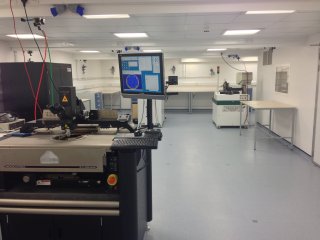 The GLADD is a clean room. A clean room is a controlled environment. Here are some instructions for 'best practice' use of this important room.
The GLADD is a clean room. A clean room is a controlled environment. Here are some instructions for 'best practice' use of this important room.
ISO 14 644 defines a clean room as:
‘A room in which the concentration of airborne particles is controlled, and which is constructed and used in a manner to minimise the introduction, generation and retention of particles inside the room and in which other relevant particles, e.g. temperature, humidity and pressure are controlled as necessary.'
The definition of a class 10, 000 is < 10, 000 particles ≥ 0.5 µm per cubic foot of air.
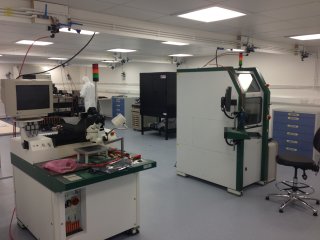 The air supply in clean rooms re-circulates through high efficiency particulate air (HEPA) filters and is at a positive pressure with the temperature and humidity controlled. Fine particles as small as 0.18 µm are filtered with 99.995 % efficiency.
The air supply in clean rooms re-circulates through high efficiency particulate air (HEPA) filters and is at a positive pressure with the temperature and humidity controlled. Fine particles as small as 0.18 µm are filtered with 99.995 % efficiency.
Clean room personnel are one of the leading sources of contamination with millions of particles being dispersed from skin and clothing - hence the requirement for a barrier in the form of clean room clothing. Thus usage of the clean room should be minimised to prevent introducing excess particles.
If work doesn’t have to be carried out in the clean room do not use the clean room to do it.
Issues with Wafers discovered by VTT
Issues with wafers have been discovered by the VTT Technical Research Centre of Finland.
Some of the main types of contamination/damage seen on wafers at incoming inspection:
- Particles - exposing substrates to air that has too many particles
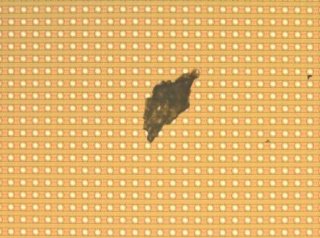
- Organic stains and metal contamination:
- Usually transferred by humans
- Especially problematic for subsequent processing
Clean Room Rules
- The clean room is a restricted area; only trained and AUTHORISED users may enter
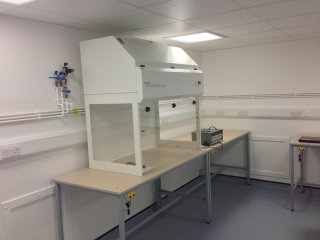
- No more than 6 people should be in this laboratory at any one time
- Doors should remain open ONLY when in use and not be held open longer than necessary
- There should be no eating, drinking or chewing gum in the clean room
- Full clean room attire MUST ALWAYS be worn in the clean room
- EXCEPT IN CASE OF EMERGENCY, such as fire alarm evacuation, personnel should not wear clean room attire outside of the clean room/changing area
- No fixture or equipment should be brought into the clean room without the prior approval of Fred Doherty.
Clean Room Protocol
Before entering the clean room changing area, remove and store all outdoor clothing and bags. Jumpers should not be worn in the clean room. Appropriate footwear must be worn, ie: no sandals or flip flops, etc. Remove any make up such as face powder which will act as a source of contaminants. No outdoor coats should be hung on the coat hangers. Do not wear torn garments.
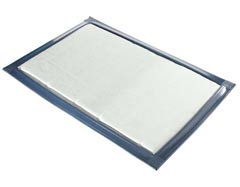 On entering the changing area:
On entering the changing area:
- Both doors of the changing area should not be open at the same time
- Apply footwear to the takmats to remove any loose dirt or debris before putting on dedicated footwear
- Do not use damaged footwear or torn garments, gloves, hair nets, face masks
- Put on a hairnet
- Sit on the 'step over' bench and put on clean room shoes/boots before swinging each foot over to the clean side
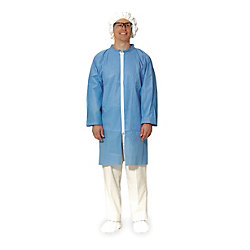
- Put on your clean room coat
- Face masks and gloves will be found both inside the changing area and in the clean room - these should be worn at all times
- Safety glasses and wrist bands will be found inside the clean room - these should not be removed from the clean room
Further instructions
- Do not take any wood-based products into the clean room - this includes non clean room paper, cardboard, pencils, tissues etc.
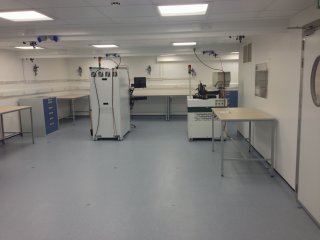
- Only use clean room paper/notebooks when necessary, use a PC where possible. Clean room notebooks must not be removed from the clean room and brought back in.
- Loose leaf clean room paper is available inside the clean room. Again, this must not be brought back in if it has been taken at any point from the clean room.
- Do not use anything that can shed or act as a source of particles.
- Mobile phones or laptops should not be brought into the clean room. Mobile phones can only be brought out of pockets and used in the changing area. If you do so, remember to put on a fresh pair of gloves when you return to the clean room.
- Return to the changing area to cough or sneeze.
- Avoid storing materials in the clean room unnecessarily. Products stored within the clean room should be kept in closed cabinets or containers. Label any items stored, along with contact details.
- Please leave the area as you would like to find it.
- Solvent contact with bare skin should be avoided. Solvents can remove skin oils and cause flaking.
- Ensure waste/sharps are discarded into the appropriate bin.
- Running is prohibited.
- Do not sit or lean on equipment or work surfaces.
On leaving the GLADD
 When leaving the clean room:
When leaving the clean room:
- Remove your clean room coat
- Remove your clean room shoes/boots while sitting on the 'step over' bench, ensuring they do not make contact with the ‘dirty’ side of the floor.
- Dispose of gloves, face masks, hair nets, etc. into the bin provided.
- IN CASE OF EMERGENCY EVACUATE WITHOUT REMOVING CLEAN ROOM APPAREL.
Warning
PLEASE NOTE: If the above rules are not adhered to, the following will occur:
1) After one breach of protocol a formal warning will be given by the PPE Group Leader, Professor A. T. Doyle.
2) If there is a second breach the user will be banned from the facility for two weeks.
3) A third offence will result in a two month ban.
4) A fourth offence will result in permanent expulsion from the GLADD.
In case of any doubt regarding GLADD procedures, or if any assistance is required, please contact either Fiona McEwan or Fred Doherty, who will be very happy to help.

